Audiology Case Study - NHS Shetland - 18 Weeks
Audiology Case Study - NHS Shetland - 18 Weeks
Audiology Case Study - NHS Shetland - 18 Weeks
Create successful ePaper yourself
Turn your PDF publications into a flip-book with our unique Google optimized e-Paper software.
Appendix A<strong>Case</strong> <strong>Study</strong> 2<strong>NHS</strong> BoardSpecialtyHigh Impact Change<strong>NHS</strong> SHETLANDENT & AUDIOLOGYREDUCTION IN WAITING TIMES AND IMPROVED SERVICEDetails of ImprovementWhat was the problem?How was this identified?What were the implemented improvements(tools/techniques)?In 2007-08, <strong>NHS</strong> <strong>Shetland</strong> had a single handed Audiologist providing thelocal service. Despite considerable redesign and modernisation of theservice by the Audiologist, the service was still experiencing difficultyproviding a responsive service and the maximum waiting time to firstassessment in 2008 was 30 weeks in November 2008.The Audiologist already collected extensive data on case mix and waitingtimes so this was used initially to look at the demand and capacity withinthe existing service. This data showed that whilst the access times for theservice were improving – there needed to be a step change in order tomeet the 12-week target by March 2009. It was agreed that a morefocused project needed to be undertaken to understand the referral andassessment pathway and where queues were forming. A successfulbusiness case was also taken forward to secure additional technicalsupport, increasing the establishment from WTE 0.5 to WTE 1.0.From November 2008 onwards, a full time <strong>Audiology</strong> Technician wasemployed in order to support the Audiologist and provide additionalcapacity to undertake the hearing aid repair service as well as providing<strong>Audiology</strong> <strong>Case</strong> <strong>Study</strong> – <strong>NHS</strong> <strong>Shetland</strong>Published on: www.<strong>18</strong>weeks.scot.nhs.uk/how-to-achieve-and-maintain-<strong>18</strong>-weeks/task-and-finish-groups/audiology/(July 2010)1
administrative support for patient call/recall.In addition to this, a formal Demand Capacity and Queue (DCAQ)exercise was undertaken for 13 weeks to better understand mismatchesin the capacity to deliver the service and the pattern of demand. Throughbetter understanding of the demand and capacity issues, it wasdetermined that additional <strong>Audiology</strong> time would be needed betweenJanuary and March 2009, to reduce the backlog of cases that had built upover time. Additional capacity was provided by locum staff to help reducethe backlog and ensure that the Audiologist had a manageable workloadgoing into 2009-10.This work was also supplemented by a number of process mappingevents held in conjunction with ENT services. This enabled the multidisciplinary team to better understand the patient pathway and redesignkey stages to make the process more efficient. Improvements includereleasing the capacity of the Audiologist to focus on assessments andhearing aid fittings through the provision of additional technical support.Other improvements include the introduction of pre-assessment clinics forpatients requiring audiograms before attending the ENT clinic, which hasled to more efficient utilisation of the Audiologist’s time and ENT capacity.The Audiologist has also reviewed the pathway for children accessing theservice and additional clinics are planned when the forecasted demandincreases. Additional capacity for the children’s clinic has been madepossible through the inclusion of the <strong>Audiology</strong> Technician, who workswith the child during the test (reducing the fail rate of the test).Strategies to reduce DNA rates are also being implemented.<strong>Audiology</strong> <strong>Case</strong> <strong>Study</strong> – <strong>NHS</strong> <strong>Shetland</strong>Published on: www.<strong>18</strong>weeks.scot.nhs.uk/how-to-achieve-and-maintain-<strong>18</strong>-weeks/task-and-finish-groups/audiology/(July 2010)2
What is the situation now? Maximum waiting time from assessment to hearing aid fitting was 13weeks in June 2009.The <strong>Audiology</strong> Technician is continuing to build technical skills and takemore appropriate training that will enable an increasing level ofassistance, therefore increasing departmental efficiency.How is the change sustainable?“Sustainability can be defined as being achievedwhen new ways of working and improvedoutcomes become the norm.”Regular monitoring and management of waiting times and clinic levels willprevent the waiting times from rising to the levels last seen in November2008. The introduction of process mapping reviews and the 13-weekDCAQ has allowed for a much clearer process overview, therefore greatercontrol.Describe how this improvement is sustainable.Measurable outcomeE.g. DNA rates, CNA rates, DCAQ, time fromreferral to report available, waiting times.Overall waiting times for <strong>Audiology</strong> pathways and ENT pathwaysDCAQ looking at all clinical and non-clinical activities. For example, thedemand for hearing aid assessment, activity for hearing aid assessmentundertaken and backlog (set against clinical capacity available).Identifying activities that could be undertaken by other staff (e.g. admin,organising locum work, technical services etc) and agreeing the changesthat could be made to shift activity elsewhere.What are the patient benefits? – E.g. qualitativedata – results of patient surveys, patient stories,quotes from patients.Reduced waiting times to access the service. Drop from 30 weeks for firstassessment down to 4-5 weeks on average. Overall journey time(maximum) for June 2009 was 13 weeks from referral to hearing aidfitting.<strong>Audiology</strong> <strong>Case</strong> <strong>Study</strong> – <strong>NHS</strong> <strong>Shetland</strong>Published on: www.<strong>18</strong>weeks.scot.nhs.uk/how-to-achieve-and-maintain-<strong>18</strong>-weeks/task-and-finish-groups/audiology/(July 2010)3
Improved access – the service is available 5 days per week from 8am to5pm (increasing the number of staff in the team has increased theopening times).Improved cross cover – before the Technician joined the team, the servicewould close if the Audiologist was unavailable. The addition of secondmember of staff means there is increased cross over so services such ashearing aid repair can continue when the Audiologist is not available.What are the staff benefits? – e.g. qualitativedata results of staff surveys, staff stories, quotesfrom staff.The Audiologist has been able to focus on core business instead ofcovering technical duties and administrative duties. This has providedmore time for service review and evaluation of the DCAQ data – enablingthe Audiologist to refine and develop new systems and services. Anexample of this is that the Audiologist has re-instated pre-assessmentclinics to meet demand for diagnostics via the ENT pathway.The Audiologist has also increased capacity to provide diagnosticservices and address the longer waiting times (e.g. assessments andfittings) as hearing aid repair and other technical duties have been pickedup by the Technician.The Technician has been on various training courses and reports that shefeels more confident in the role and since April 2009, has been managingher own caseload for hearing aid repair.What are the organisational benefits?Clearly defined, efficient care pathways for patients requiring <strong>Audiology</strong>assessment and hearing aid services. Process and outcome measuresare in place enabling management teams to review performance andbetter understand issues such as spikes in demand and how to respondproactively (e.g. continuity planning for holidays and how this will affectdemand management/access to the service).<strong>Audiology</strong> <strong>Case</strong> <strong>Study</strong> – <strong>NHS</strong> <strong>Shetland</strong>Published on: www.<strong>18</strong>weeks.scot.nhs.uk/how-to-achieve-and-maintain-<strong>18</strong>-weeks/task-and-finish-groups/audiology/(July 2010)4
How did staff feel before theimprovement/during the improvement and afterthe improvement?The Audiologist had already undertaken a programme of service redesignand modernisation and the work she had done put us in a good position tomove forward.The <strong>Audiology</strong> team reported that they felt the improvements weremanageable (always predicted they would be on target for March) but thework level was considerable between November 2008 and March 2009and this created pressure in the team. In particular maintaining theprovision of service, training new staff and organising additional locuminput.Staff are pleased with the achievements and the work undertaken toreduce waiting times, streamline the patient pathways and increaseservice provision. This has been the catalyst for other changes includingclose working with ENT services and introducing pre-assessment servicesto support ENT.What are the lessons learnt and what wouldyou do differently next time?What plans are there to spread theimprovement?Start the review work earlier.Consider brining in locum support earlier to take the pressure off the<strong>Audiology</strong> team and bring the waiting times down in a progressive wayrather than step change.DCAQ is also being used in other projects such as theatre utilisation andworkforce planning.<strong>Audiology</strong> <strong>Case</strong> <strong>Study</strong> – <strong>NHS</strong> <strong>Shetland</strong>Published on: www.<strong>18</strong>weeks.scot.nhs.uk/how-to-achieve-and-maintain-<strong>18</strong>-weeks/task-and-finish-groups/audiology/(July 2010)5
ContactsName, title, email and phone number for key contacts:Contact Name Email Telephone number<strong>Case</strong> study owner COLIN BELL colin.bell@nhs.net 01595 743000 ext. 3468Key department contact (e.g.clinical lead/unit manager)KATHLEENCAROLANkathleen.carolan@shb.shetland.scot.nhs.uk 01595 743000 ext. 3<strong>18</strong>8<strong>Audiology</strong> <strong>Case</strong> <strong>Study</strong> – <strong>NHS</strong> <strong>Shetland</strong>Published on: www.<strong>18</strong>weeks.scot.nhs.uk/how-to-achieve-and-maintain-<strong>18</strong>-weeks/task-and-finish-groups/audiology/(July 2010)6


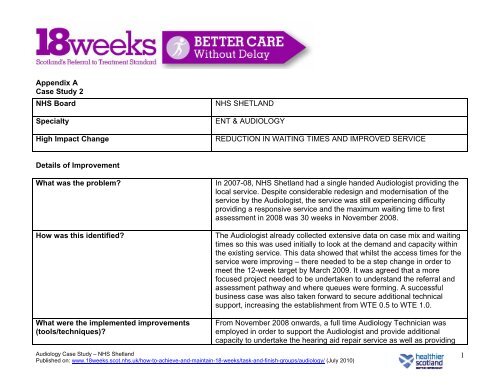
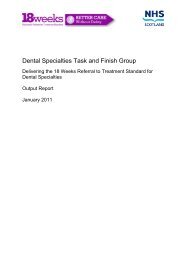

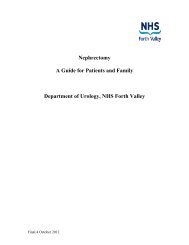
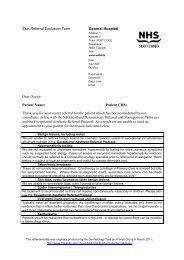
![Dr Matthew Checketts, NHS Tayside [PDF - 6Mb] - 18 Weeks](https://img.yumpu.com/49027155/1/190x143/dr-matthew-checketts-nhs-tayside-pdf-6mb-18-weeks.jpg?quality=85)

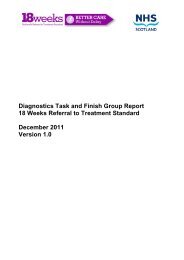

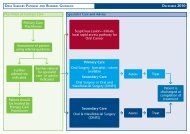


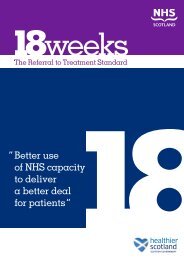
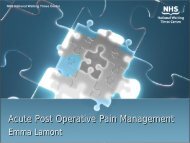
![Mark Sindall, NHS Dumfries and Galloway [PDF - 227Kb] - 18 Weeks](https://img.yumpu.com/30080335/1/190x143/mark-sindall-nhs-dumfries-and-galloway-pdf-227kb-18-weeks.jpg?quality=85)